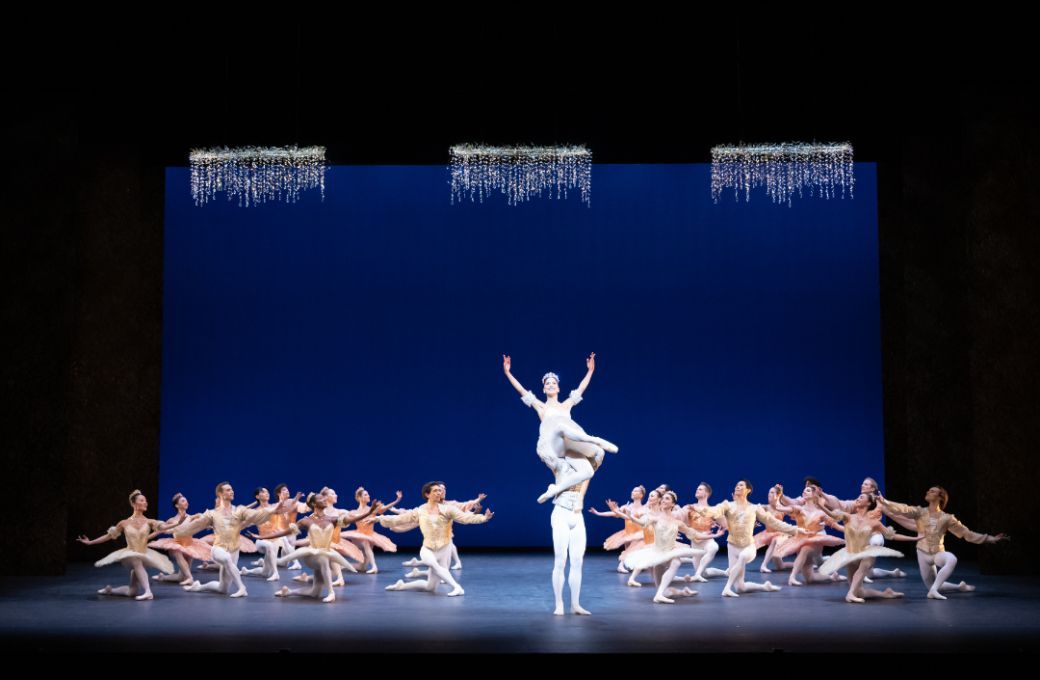There were a few first night jitters at the start of English National Ballet’s season opener, a quadruple bill titled R:Evolution. In an impressively diverse programme, it was George Balanchine’s challenging 1947 Theme and Variations which set the standard for the evening.

With Tchaikovsky’s grand score, Orchestral Suite no. 3, and Roberta Guidi di Bagno’s sparkling tutus, it is one of those ballets that never fails to induce goosebumps. However, along with the spectacle, it’s fiendishly difficult to execute and highly exposing. It contains Balanchine’s signature swift changes in direction, intricate batterie and complicated turns. On top of this, much of it requires speed, which in turn pushes stamina to the limit.
The corps de ballet were immaculately well drilled, with clean lines and crisp footwork. A disconcerting wayward headdress malfunction did not break the concentration. The four demi-soloist couples looked supremely confident and at ease.
Artistic director Aaron S. Watkin chose to invite guest artists Alice Mariani from La Scala and Ricardo Castellanos from Norwegian National Ballet to lead the company on the first night. Both survived the pressure but Mariani looked more relaxed. She danced with elegance and unforced joy. Particularly good were the many sequences of convoluted pirouettes where her musicality and control allowed her to draw out balances at the end of the phrase to quite spectacular effect.
Castellanos is a handsome, smooth dancer who I’ve seen deliver many top notch performances with NNB. I suspect that lack of familiarity with his partner and the company may have felt a little overwhelming. While he did not ever lose his composure there were some slightly untidy take-offs and landings in the tricky series of double tours en l’air and an unfortunate botched shoulder lift at the close of the ballet. I am sure that if they had had another chance, these things could have been ironed out. Sadly, it was a one-off appearance.
Martha Graham’s Errand into the Maze, also created in 1947, is a wonderful addition to ENB’s repertoire. Based on the Greek myth about Theseus, Ariadne and the minotaur, here Graham has reimagined Theseus as a woman, empowered and strong enough to overcome The Creature of Fear. It’s hard to believe that it was created nearly 80 years ago, it looks so current. For the right dancers, it is a real gift. Emily Suzuki and Rentaro Nakaaki, both making their debuts, were outstanding and entirely suited to the roles. Movements were jarring, angular, with sinister undertones but never less than enthralling.
After a brief pause, William Forsythe’s Herman Schmerman (Quintet) leapt into another era (1992) bearing all of his hallmark swagger. For two men and and three women, it was Caroline Galvao who confidently stepped in for an injured Ivana Bueno and danced very well indeed. Aitor Arrieta and Rhys Antoni Yeomans gave superlative performances as the men, particularly when dancing solo. Yeomans is the ultimate proponent of the Forsythe vocabulary, watchable even when he’s simply stretching his beautifully arched feet. Alice Bellini and Swanice Luong pushed themselves hard throughout with sassy, gutsy movements, with the thrusting hips and strutting walks now very familiar. There was a delightful, surprise ending which I’d forgotten about, but no spoilers here!
Such contrasting ballets on one programme allows the viewer to really savour each one properly. David Dawson’s magnificent Four Last Songs from 2023 closed the evening. Set to Richard Strauss’ bewitching songs, beautifully sung by Madeleine Pierard at the side of the stage, Dawson has created something transcendental. It’s akin to being put under a spell. The dancers, in their nude leotards, rippled mellifluously. They unfolded, melted, flew in carefully structured patterns. One moment on the floor, then lifted into the air seamlessly, propelled by partners who carried them with no obvious effort. Pliés were endlessly elastic, even running across the stage took on an otherworldly appearance. Sangeun Lee and Gareth Haw were mesmerising, weaving their lissome limbs around Dawson's ever more fluid movements.
What appealed most of all was the connection between the music and the expressive use of the upper body. A transporting experience, I cannot fault anything or anyone in what was one of the most exemplary and moving performances I’ve seen recently. Maria Seletskaja, conducting the excellent English National Ballet Philharmonic made it all even better.


